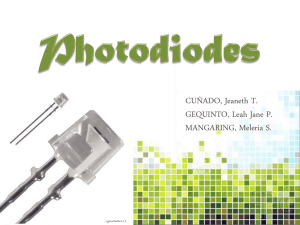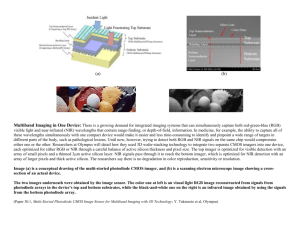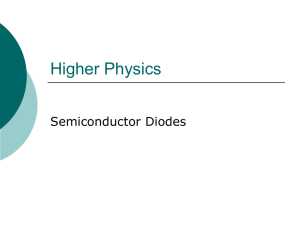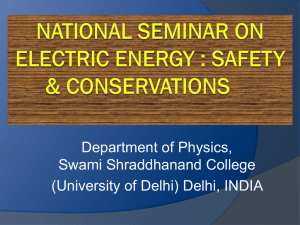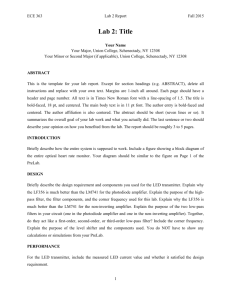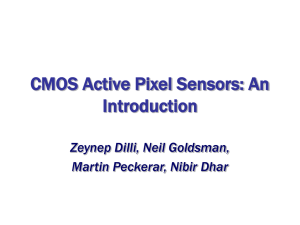Figure 2 : IV and CV Caractéristics of a photodiode
advertisement
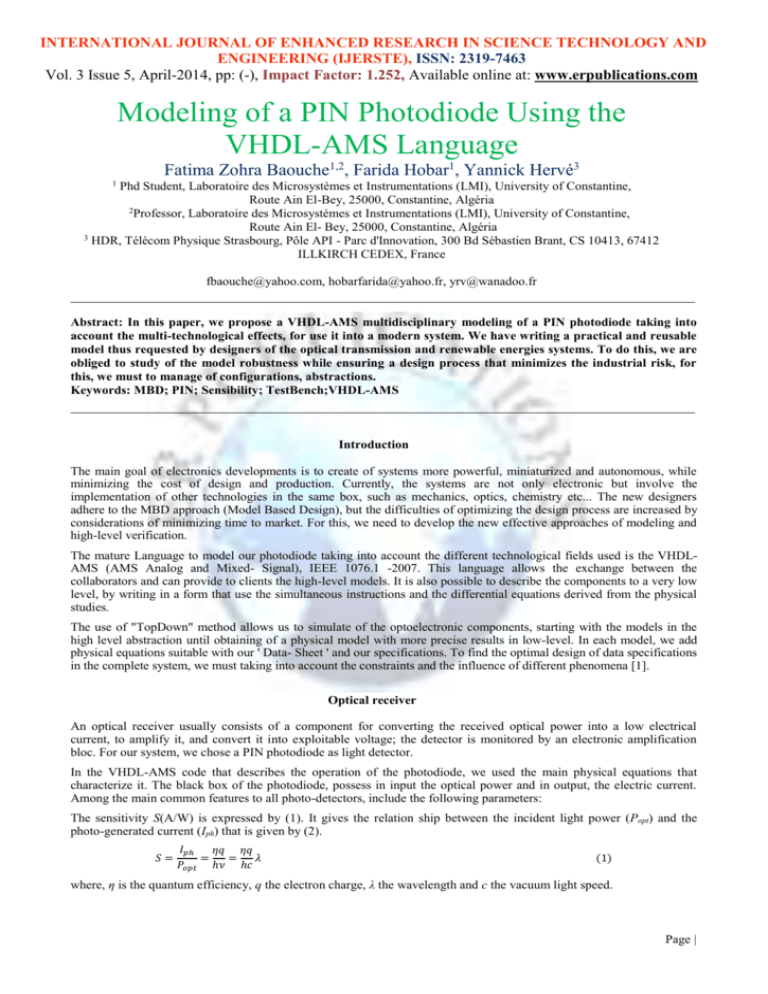
INTERNATIONAL JOURNAL OF ENHANCED RESEARCH IN SCIENCE TECHNOLOGY AND ENGINEERING (IJERSTE), ISSN: 2319-7463 Vol. 3 Issue 5, April-2014, pp: (-), Impact Factor: 1.252, Available online at: www.erpublications.com Modeling of a PIN Photodiode Using the VHDL-AMS Language Fatima Zohra Baouche1,2, Farida Hobar1, Yannick Hervé3 1 Phd Student, Laboratoire des Microsystèmes et Instrumentations (LMI), University of Constantine, Route Ain El-Bey, 25000, Constantine, Algéria 2 Professor, Laboratoire des Microsystèmes et Instrumentations (LMI), University of Constantine, Route Ain El- Bey, 25000, Constantine, Algéria 3 HDR, Télécom Physique Strasbourg, Pôle API - Parc d'Innovation, 300 Bd Sébastien Brant, CS 10413, 67412 ILLKIRCH CEDEX, France fbaouche@yahoo.com, hobarfarida@yahoo.fr, yrv@wanadoo.fr Abstract: In this paper, we propose a VHDL-AMS multidisciplinary modeling of a PIN photodiode taking into account the multi-technological effects, for use it into a modern system. We have writing a practical and reusable model thus requested by designers of the optical transmission and renewable energies systems. To do this, we are obliged to study of the model robustness while ensuring a design process that minimizes the industrial risk, for this, we must to manage of configurations, abstractions. Keywords: MBD; PIN; Sensibility; TestBench;VHDL-AMS Introduction The main goal of electronics developments is to create of systems more powerful, miniaturized and autonomous, while minimizing the cost of design and production. Currently, the systems are not only electronic but involve the implementation of other technologies in the same box, such as mechanics, optics, chemistry etc... The new designers adhere to the MBD approach (Model Based Design), but the difficulties of optimizing the design process are increased by considerations of minimizing time to market. For this, we need to develop the new effective approaches of modeling and high-level verification. The mature Language to model our photodiode taking into account the different technological fields used is the VHDLAMS (AMS Analog and Mixed- Signal), IEEE 1076.1 -2007. This language allows the exchange between the collaborators and can provide to clients the high-level models. It is also possible to describe the components to a very low level, by writing in a form that use the simultaneous instructions and the differential equations derived from the physical studies. The use of "TopDown" method allows us to simulate of the optoelectronic components, starting with the models in the high level abstraction until obtaining of a physical model with more precise results in low-level. In each model, we add physical equations suitable with our ' Data- Sheet ' and our specifications. To find the optimal design of data specifications in the complete system, we must taking into account the constraints and the influence of different phenomena [1]. Optical receiver An optical receiver usually consists of a component for converting the received optical power into a low electrical current, to amplify it, and convert it into exploitable voltage; the detector is monitored by an electronic amplification bloc. For our system, we chose a PIN photodiode as light detector. In the VHDL-AMS code that describes the operation of the photodiode, we used the main physical equations that characterize it. The black box of the photodiode, possess in input the optical power and in output, the electric current. Among the main common features to all photo-detectors, include the following parameters: The sensitivity S(A/W) is expressed by (1). It gives the relation ship between the incident light power (Popt) and the photo-generated current (Iph) that is given by (2). 𝑆= 𝐼𝑝ℎ 𝜂𝑞 𝜂𝑞 = = 𝜆 𝑃𝑜𝑝𝑡 ℎ𝜈 ℎ𝑐 (1) where, η is the quantum efficiency, q the electron charge, λ the wavelength and c the vacuum light speed. Page | INTERNATIONAL JOURNAL OF ENHANCED RESEARCH IN SCIENCE TECHNOLOGY AND ENGINEERING (IJERSTE), ISSN: 2319-7463 Vol. 3 Issue 5, April-2014, pp: (-), Impact Factor: 1.252, Available online at: www.erpublications.com The dark current (Iobs) is sometimes called the sensitivity limit, the current deducted even if the photodiode is plunged into total darkness, i.e. that the PN junction can generate the electrons, even in the absence of light. Generally, Iobs remains very low, of a few nano-amperes or pico-amperes. But also, it greatly increases with the photodiode polarization, the active surface, and the temperature. 𝐼𝑝ℎ = 𝑆𝑃𝑜𝑝𝑡 + 𝐼𝑜𝑏𝑠 (2) . Electrical model of the PIN photodiode To model the photodiode PIN, we used the dynamic model of the VCSEL and the model of the graded index optical fiber created in [2]. The current flow through the photodiode is caused by the generation of electron-hole pairs, which in turn is the result of lighting of the photodiode PIN by an incident flux. The operation of the photodiode is described by the continuity equations binder the carriers to currents, to recombination rates, and to generation rates according to the (3) and (4) [3]. 𝑑𝑆 1 = 𝐺 − 𝑅𝑠 − 𝛻𝐼𝑠 𝑑𝑡 𝑞 (3) 𝑑𝑁 1 = 𝐺 − 𝑅𝑛 − 𝛻𝐼𝑛 𝑑𝑡 𝑞 (4) where G is the generation rate, Is and In are respectively the of holes and electrons density, Rs et Rn the recombination rate respective of each type of carrier. The total current of a photodiode is expressed by (5). 𝑞𝑉𝑑 𝐼 = 𝐼𝑠 (𝑒𝑥𝑝 ( − 1)) − 𝐼𝑃ℎ 𝐾𝑇 (5) The Fig. 1 [4], show the electrical equivalent circuit of the PIN photodiode. The photo-generated current created by the photon effect is modeled by a current source. An ideal diode is connected in parallel, which also allows modeling the passage of the dark current in parallel with the parasitic junction capacitance (Cj). A parasitic resistance of high value (denoted Rsh, shunt resistor) is added to the model. Figure 1: Electrical equivalent circuit of the PIN photodiode. The shunt resistor of an ideal photodiode is infinite. In reality, this resistance is between the 1GΩ and 100kΩ, according to photodiode quality. It is used to calculate the leakage current (or noise) in the photovoltaic mode (without bias) of the photodiode [5]. In the photodiode model, we showed a parasite Cj capacity due to the load area and find its origin in the PN junction. It is inversely proportional to the width of space charge (W) according to the (6). The junction capacitance varies around 100pF for low polarization to a few tens of pF for high polarizations. 𝐶𝑗 = 𝑠 𝐴 𝑤 (6) where ε is the material permittivity, A is the active area and W is the width of the space charge zone that is proportional to the inverse polarization. Bandwidth reflect Bandwidth reflects the speed at which the photodiode responds, after a variation of the optical power, the response time or rise time tr3 may then introduced. It is defined as the time required achieving 90% to 100% of the final current in the photodiode. The equation (7) [6] provides an approximation between bandwidth f3dB and response time. You can then set the bandwidth associated with this response time by (8). The response time of a light pulse, according to the conventional standard 10% - 90% can be estimated by (9). Page | INTERNATIONAL JOURNAL OF ENHANCED RESEARCH IN SCIENCE TECHNOLOGY AND ENGINEERING (IJERSTE), ISSN: 2319-7463 Vol. 3 Issue 5, April-2014, pp: (-), Impact Factor: 1.252, Available online at: www.erpublications.com 𝑡𝑟 = 0.35 𝑓3𝑑𝐵 𝐵𝑃 = (7) 0.35 𝑡𝑟 (8) 2 2 2 𝑡𝑟 = √𝑡𝑡𝑟𝑎𝑛𝑠𝑖𝑡 + 𝑡𝑑𝑖𝑓𝑓 + 𝜏𝑅𝐶 (9) Where, ttransit is the carriers travel time in the space charge zone, tdiffle is the carriers diffusion time in the zone N or P, τRC the time constant of the equivalent circuit it is equal to RSh.Cj. The Time ttransit and tdiff reduced if the polarization voltage Vp increases, they are often lower to τRC. But every time is difficult to determine, only the total time is taken into account. In general, the transmission time is slower than the transit time. To model the behavior of the photodiode, we have added to our VHDL-AMS model, the following equations: 𝐼 = − 𝐼𝑝ℎ + 𝐼𝑐𝑗 + 𝐼𝑠ℎ 𝐼𝑠ℎ = (10a) 𝑉𝑑 𝑅𝑠ℎ 𝐼𝑐𝑗 = 𝐶𝑗 . (10b) 𝑑𝑉𝑑 𝑑𝑡 (10c) 𝐼𝑑 = 𝐼𝑠 (𝑒𝑥𝑝 (𝑞 𝑉𝑑 ) – 1) 𝐾𝑇 (10d) 𝑉 = 𝑉𝑑 + (𝑅𝑠ℎ ∗ 𝐼) (10e) where Ish is the current through the shunt resistor, Icj the current through the capacitance junction, K the Boltzman constant, T the temperature. Static analysis We begin our modeling by a static analysis (DC) to present the IV characteristic and the variation of the photodiode capacitance as a function of polarization (see Fig. 2). This capacitance comes with the shunt resistor in the PIN photodiode speed and the bandwidth. Figure 2 : IV and CV Caractéristics of a photodiode PIN. Page | INTERNATIONAL JOURNAL OF ENHANCED RESEARCH IN SCIENCE TECHNOLOGY AND ENGINEERING (IJERSTE), ISSN: 2319-7463 Vol. 3 Issue 5, April-2014, pp: (-), Impact Factor: 1.252, Available online at: www.erpublications.com Fig. 3, shows the variation of current through the junction capacitance as a function of the bias voltage. We note that the current begins to decrease to a voltage of 0.5 V because of the space charge region also decreases with increasing bias voltage. Figure 3: Variation of the current through the junction capacitor. Another important characteristic of the photodiode is its sensitivity. This is to show the variations of the sensitivity (S) depending on the wavelength (λ), as illustrated in Fig. 4. We Note that sensitivity increases as the wavelength; it also adds a thermal variation due to the temperature influence on the Gap energy. For the wavelength of 850 nm, the sensitivity value is equal to 0.63 A / W. Figure 4: Sensitivity Variations of the PIN photodiode. In our case, the photodiode is reverse biased, a low dark current flow even in the absence of optical power, as shows in Figs.5. The dark current increases slowly with increasing bias and temperature. Our results are consistent with those found by [3]. Page | INTERNATIONAL JOURNAL OF ENHANCED RESEARCH IN SCIENCE TECHNOLOGY AND ENGINEERING (IJERSTE), ISSN: 2319-7463 Vol. 3 Issue 5, April-2014, pp: (-), Impact Factor: 1.252, Available online at: www.erpublications.com Figure 5: Obscurity current variations versus of: (a) the polarization voltage, (b) the temperature. Conclusion We have presented in this paper the modeling results of a photodiode PIN necessary to make operate some renewable energy systems. Thus, our modeling permit optimizes the reception circuits in an optical communication system. References [1] Y. Hervé, “VHDL-AMS application et enjeux industriels,” Dunod éditeur. ISBN 2100058886. Paris 2002. [2] FZ. Baouche, F. Hobar and Y. Hervé, “HIGH LEVEL MODELING IN OPTOELECTRONIC SYSTEMS: TRANSMISSION LINE APPLICATION,” International Journal of Advances in Engineering & Technology, IJAET ISSN: 2231-1963. Vol. 6, Issue 1, pp. 392-404, Mars 2013. [3] P. Lévêque, “composants optoélectronique,”, CNRS-InESS, Strasbourg. [4] M. Karray, “Contribution à la modélisation hiérarchique de systèmes opto-électroniques à base de VHD-AMS,” doctoral thesis, University of Strasbourg, 2005. [5] M. Ouertani, “Fibres Optiques,” Chapitre 2, Département Architecture des systèmes et des réseaux ISI, 2008/2009. [6] E. Bahaa, A. Saleh, C-Teich.Malvin, “SEMICONDUCTOR PHOTON DETECTORS,” Copyright 1991 John Wiley & Sons, Inc. ISBNs: 0-471-83965-5 (Hardback); 0-471-2-1374-8 (Electronic). Page |
